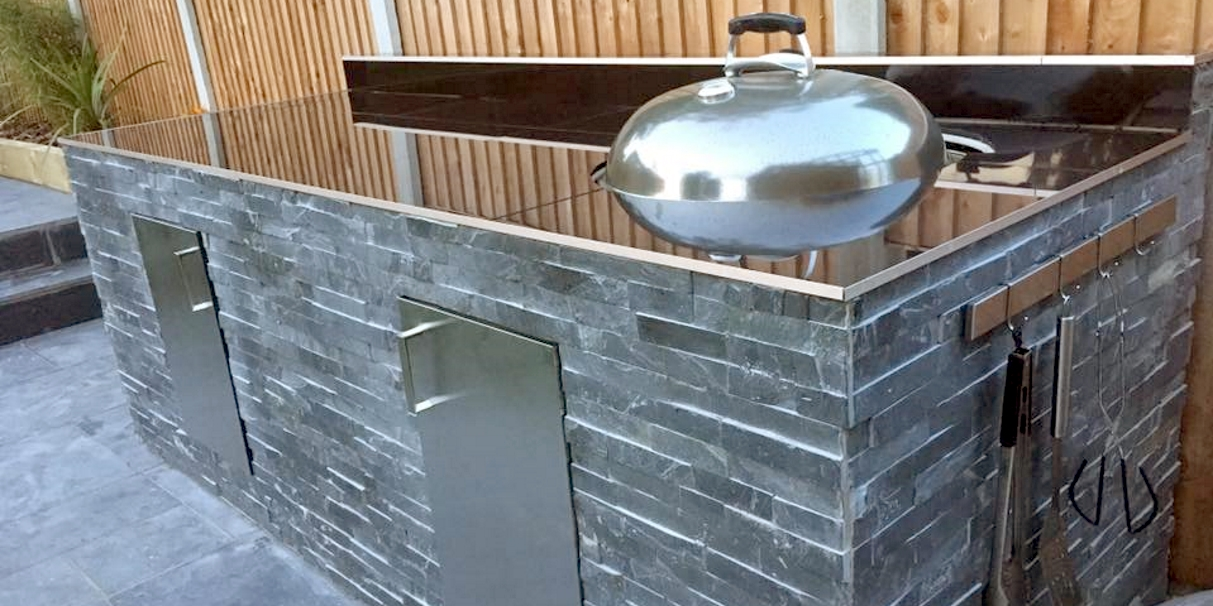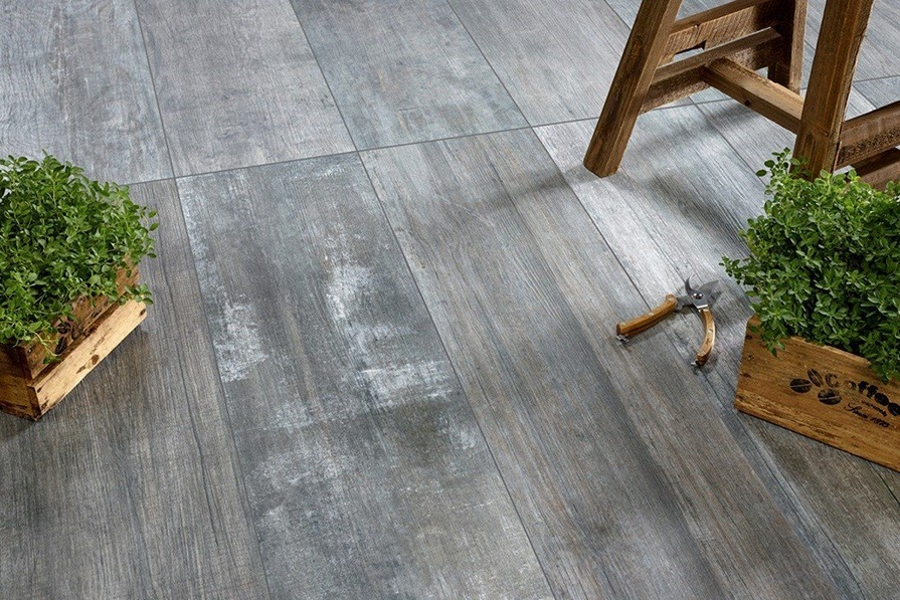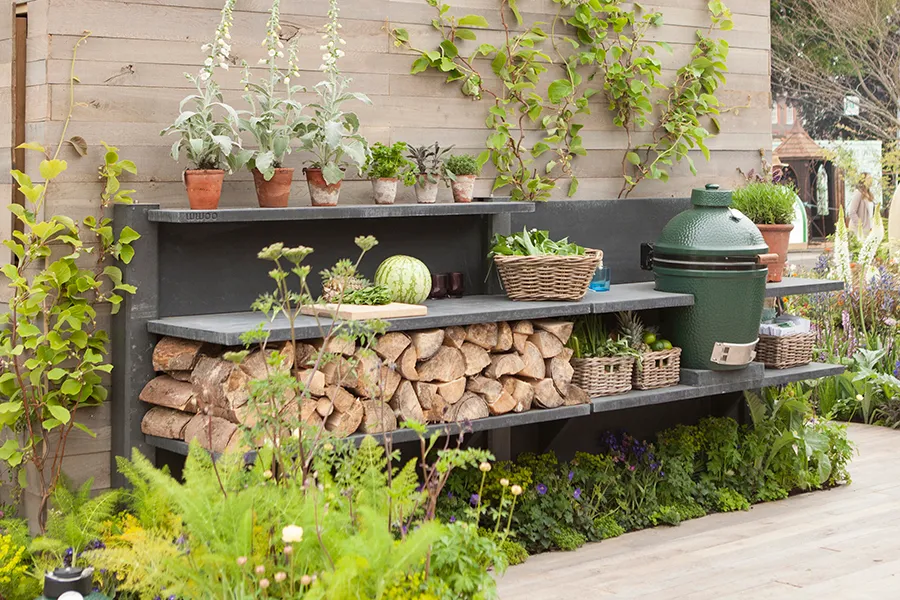With warmer weather comes the desire to spend as much time as possible outside. It’s always best to treat your garden as an extension of your home and utilise the space you have in the best way possible. When hosting a barbecue, how many times have you raced back and forth to the kitchen in the house for a spot to prep, to use the sink, or even to fetch another ice cold beer? The constant back and forth can detract from enjoying the get-together, which is why many people are now opting for something so much simpler – an outdoor kitchen.
Popular across the pond and in warmer climates, it may seem an odd choice for our shores but the truth is, the more you invest in your outdoor space and the more practical and comfortable it is and the longer the time you’ll want to spend there. And, when your garden has more than just a barbecue and a couple of folding chairs, it becomes the perfect entertaining area; a place to spend time with family and with friends (even if the sun is dodging in and out of the clouds).
Creating an outdoor kitchen can be as complicated or as simple and practical a project as you want to make it. From full blown inbuilt gas barbecues, pizza ovens, and built-in refrigerators (best to call in the professionals) to simple shelving and an incorporated grill (if you fancy the DIY route), the possibilities are limitless. If you’re in need of some inspiration and a few tips on creating your own outdoor kitchen then read on…
Choose Weather-Friendly Materials
One of the most important elements of creating an outdoor kitchen is the practicality of the materials you use. Considering it will need to withstand everything the British climate throws at it – from the heat of the midday summer sun to the downpours we often get at the end of the season – using the right materials is paramount. You won’t have the option to use the same materials you would use in your kitchen indoors so you’ll need to ensure everything is weatherproof.
It’s here where tiles come into their own. Whereas timber decking is subject to wear and tear, fades in the sunshine, requires constant maintenance, and needs to be replaced more often, tiles provide a practical flooring material which easily trumps all of decking’s shortcomings. Considering the anti-slip properties of materials you use on the floor is also paramount.
Traditional paving slabs can hold a lot of moisture and this means that they are subject to moss and algae growing on their surfaces which makes them slippy. Our Portico range of outdoor tiles all have a slip rating of R11 or higher, meaning that they can be subjected to direct exposure to water and still remain safe underfoot as they don’t absorb water, and stains. You can learn more about slip ratings in our useful Slip Ratings Explained feature and work out which tiles will be best suited for which situations.
With various colours and styles available, Portico includes an extensive selection of frost-proof products spanning sand-based flagstone effect right through to plank-like tiles authentically replicating aged timber. Even the wood effect variants within the range don’t require any post-installation sealing, saving you time and hassle and allowing you to enjoy your kitchen a lot quicker!
When installing tiles around a stove or a wood-burner, we recommend using either porcelain or natural stone tiles which contain less moisture and are less prone to frost damage or cracking than ceramic tiles. For the installation of outdoor floor tiles, we’d recommend using a weatherproof adhesive such as Mapei Adesilex P4 on top of a level concrete screed. This will increase their longevity and reduce the chances of cracking due to uneven installation or water pooling in indents.
Outdoor worksurfaces can also benefit from the installation of tiles for many reason, the main one being their durability and ease of cleaning. If opting for tiled work-surfaces, we would recommend our Kerapoxy grout as it’s fully waterproof as well as food-safe. You can find more information for using tiles for worktops in our handy guide.
Plan Your Storage Space
Consider how you might use the space you have. If you have existing fence panels along one end of your garden, shelving units that span across your ‘kitchen’ area are a practical option. While closed cabinets create a more traditional kitchen aesthetic, there may be more practicality for creating an open shelving effect instead. This allows more air circulation during the wettest months, keeping condensation and mildew at bay.
If you build your kitchen around your existing barbecue, you’ll have more surface area for prep, saving the dashes into the kitchen where inevitably, a burger or steak slides straight off the plate on the way. We love the look of these outdoor kitchens by Dutch company WWOO, created with concrete, perfect for our changeable climate.
The concrete elements can be easily swapped with 18-20mm thick slab tiles such as our Surface Outdoor or Dakota Outdoor (for those who prefer a riven texture to their surfaces), providing a bespoke aesthetic when cut to custom sizing. Pair with a ‘Big Green Egg’ charcoal BBQ as the striking centrepiece of your design and you can really create an alfresco dining experience like no other.
Personalise Your Design
Of course, as we said at the start, your outdoor space should be an extension of your indoor style. So whether you appreciate rustic touches in your decor or prefer the clean lines of minimalism, make sure your outdoor kitchen design mirrors your interior look. This will create better continuity of indoor and outdoor spaces, blending the areas to create a whole – you can find out more about how to best utilise the Outdoor/Indoor aesthetic in our Outdoor to Indoor Tile Guide. When it comes to colour schemes, we love the striking hues of this outdoor kitchen as seen in Cuprinol’s summer lookbook above which incorporate their outdoor paints for a bright eclectic outdoor space.
If you’re looking for outdoor tiles for your project, check out our whole Portico range and remember to take advantage of our free cut sample service before making a buying decision too.
Have you seen these posts on the Tile Mountain blog?
Introducing Portico: A New Collection of Indoor to Outdoor Slab Tiles
As a multi-award winning interior design content creator, Kimberly Duran is an Interior Design-obsessed American ex-pat, who chronicles her decorating journey and dispenses interior design advice in her personal blog, Swoon Worthy. When she’s not helplessly drooling over all the latest trends in design, she’s adding things to the imaginary ‘shopping basket’ in her head, she likes to get messy tackling DIY projects with her partner in crime, Wayne, stalking eBay for vintage bargains and filling her home with her favourite neutral – gold.





